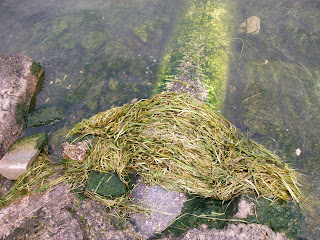
An almost-forgotten acquaintance turned up again this summer. None of us were happy about it. We started seeing way too much of this old “pal” in my neighborhood. Now we’re wondering why.
What I’m talking about is algae. It is seemingly everywhere in the waters of the western basin of Lake Erie. I have lived within eyesight of this most southern of the Great Lakes practically my whole life. I’ve been around long enough to remember similar lake conditions in the 1960s. It wasn’t pretty then; it’s not a pretty sight now.
Actually, I had almost forgotten about the mats of gelatinous material floating in our harbors and huge patches of the lake glowing pea green. At least to the extent I saw them late this summer.
For many years, following the ban on the use of phosphorus in detergents and the passage of the Clean Water Act, the actions taken to restore the Lake’s health (more accurately slow its decline) seemed to be having their intended effect. Most of the algae disappeared and the lake's water cleared. Many of us felt the lake was on the mend. But, when the algae erupted in such quantities again this summer, we became less sure. The lake's health appears to be regressing to conditions we hadn't seen in decades.
What does this have to do with the Green Industry? In my opinion, plenty.
The presence of algae in such quantities in Lake Erie involves three issues key to our industry — water quality, nutrient management and the role of turfgrass. The need for the first of the three is obvious. Questions surrounding the other two are gaining traction in the popular press and with lawmakers. That they’ll eventually become bigger here is an almost ce
 rtainty as evidenced by rules in Minnesota and many regions of Michigan in recent years banning the use of phosphorus fertilizers on home lawns and commercial properties except where soil tests indicate a phosphorus deficiency or when establishing new turfgrass.
rtainty as evidenced by rules in Minnesota and many regions of Michigan in recent years banning the use of phosphorus fertilizers on home lawns and commercial properties except where soil tests indicate a phosphorus deficiency or when establishing new turfgrass.("County could ban urban phosphorus," Battle Creek Enquirer)
How much does modern lawn care practices contribute to the nutrient loading of streams, bays and lakes, in particular to my Lake Erie? Speaking for my small region of the Great Lakes, mostly rural northwest Ohio, my best guess is very little, at least compared to other sources of nutrients and pollutants.
To understand why the lake, especially the western basin, is so loaded with nutrients consider the geography of its watershed. A huge swath of low, fertile northwest Ohio and, to a lesser extent, northeast Indiana drains into the lake via the Maumee River, the largest river by volume emptying into the Great Lakes. Its brownish, silt-laden waters flow into Lake Erie at Toledo, Ohio. Several other usually slow-moving rivers that meander through farmland contribute to the load in this relatively shallow (average depth 30 ft.) part of the lake, as well.
Northwest Ohio, with the exception of Toledo, is mostly farmland, covered with thousands of acres of corn and soybean. Prior to settlement in the 19th Century, a goodly portion of this region of Ohio, called by early settlers The Great Black Swamp, was freshwater marshland. By the early 20th Century, farmers — many of them German immigrants — had drained the marshes, erected dikes and began turning and planting these rich, heavy soils.
Today less than 10% of the original marshlands, protected and managed by the feds and the state, remain
Nutrients also enter the lake via the Detroit River, which flows into the lake after passing between Detroit and Windsor, Canada. And, sometimes forgotten, at least by U.S. residents, are the thousands of acres of farmland abutting Lake Erie on the Canadian side of the lake.
Recognizing this, you have to wonder how much of the lake’s nutrient overload comes from turfgrass, in particular the practices used to keep it green and healthy. Do the practices we use to maintain turfgrass get more of the blame than they deserve when it comes to discussions about the health of our rivers, bays and lakes?
That varies somewhat from region to region and is dependent upon predominant land use patterns, but generally the practices that are used to grow and maintain healthy turfgrass do get more attention and blame than they deserve in discussions of water quality.

Yes, when we don’t follow best practices in our maintenance and fertility programs, we can and almost certainly do contribute to unsightly, costly and environmentally harmful effects to our water supplies. These best practices, of course, involve the intelligent use of turfgrass fertilizers. Obviously, we can't allow our chemical lawn care products, including fertilizers, to enter our waterways.
But looking at one specific example, my end of Lake Erie (the example I know most intimately), the contributions of healthy turfgrass to our environment, indeed to the health of Lake Erie, would seem to far outweigh any criticisms aimed at it as a contributor to the water quality and algae problem.
Wouldn't more and wider strips of turfgrass better protect our waterways from the runoff from our farms and along our roadways? Wouldn't larger areas of healthy turfgrass in our urban communities be preferable to pavement, asphalt and other impervious surfaces that allow runoff and all manner of pollutants into our streams, rivers and lakes?
While there have been more than a few research studies that have documented the role of turfgrass in slowing runoff and capturing pollutants, I'm wondering what scientific evidence there is that the procedures and products used in lawn care contribute to our nation's water woes. To date I haven't seen it. But if it's available, I would certainly share it on this blog. — Ron Hall

No comments:
Post a Comment